OUR EYE-WITNESS AT THE BERLIN SHOW.
Page 17
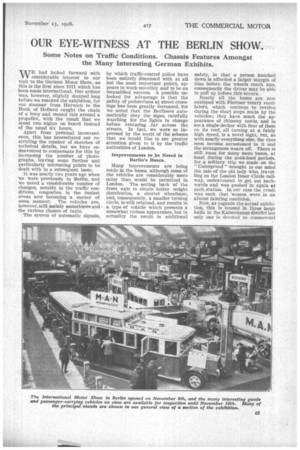
Page 18
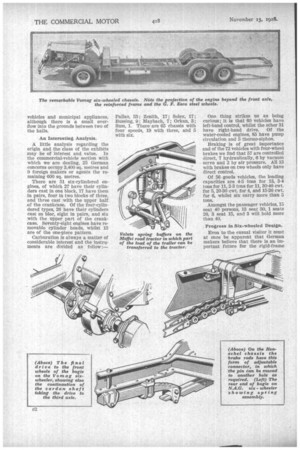
Page 19
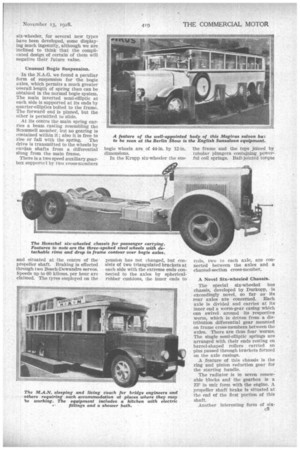
Page 20
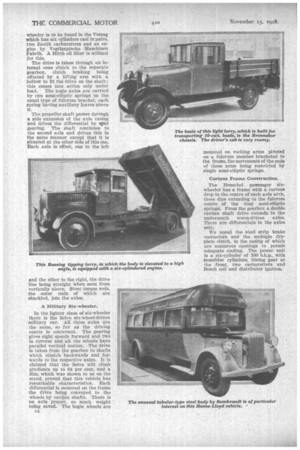
Page 21
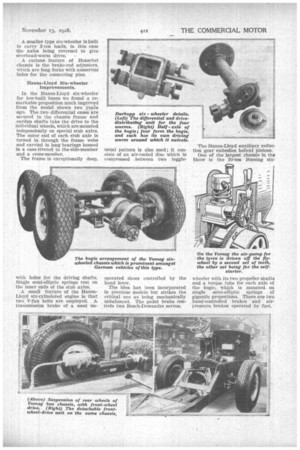
Page 22
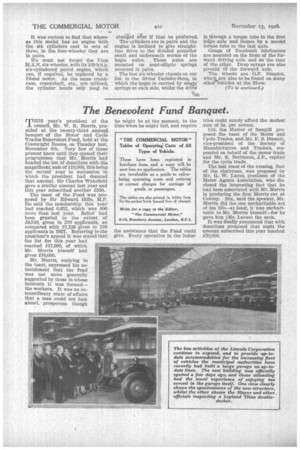
If you've noticed an error in this article please click here to report it so we can fix it.
Some Notes on Traffic Conditions. Chassis Features Amongst the Many Interesting German Exhibits.
WE had looked forward with considerable interest to our visit to the German Motor Show, as this is the first since 1911 which has been made international. Our ardour was, however, slightly damped long before we reached the exhibition, for our steamer from Harwich to the Hook of Holland caught the chain of a buoy and wound this around a propeller, with the result that we spent two nights on board instead of the usual six hours.
Apart from personal inconvenience, this has necessitated our restricting the number of sketches of technical details, but we have endeavoured to compensate for this by increasing the number of photographs, leaving some further and particularly interesting points to be dealt with in a subsequent issue.
It was nearly two years ago when we were previously in Berlin, and we noted a considerable number of • chaliges, notably in the traffic conditions, congestion in the busiest areas now becoming a matter of • some moment. The vehicles are, however, still mainly motorbuses -and the various classes of taxis.
The system of automatic signals,
by which traffic-control police have been entirely dispensed with at all but the most important points, appears to work smoothly and to be an unqualified success. A possible unlooked for advantage is that the safety of pedestrians at street crossings has been greatly increased, for we noted that the Berliners automatically obey the signs, carefully watching for the lights to change before venturing ,,fax across the streets. In fact, we were so impressed by the merit of the scheme that we would like to see greater attention given to it by the traffic authorities of London.
Improvements to be Noted in Berlin's Buses.
Many improvements are being made in the buses, although some of the vehicles are considerably more noisy than would be permitted in London. The setting back of the front axle to obtain better weight distribution, a shorter wheelbase, and, consequently, a smaller turning circle, is still retained, and results in a type of vehicle which presents a somewhat vicious appearance, but in actuality the result is additional safety, in that a person knocked down is afforded a larger margin of time before the wheels reach him, consequently the driver may be able to pull up before this occurs.
Nearly all the buses are now equipped with Flettner rotary ventilators, which continue to revolve during the short stops made by the vehicles ; they have much the appearance of chimney cowls, and to sees. single-decker with four of them on its roof, all turning at a fairly high speed, is a novel sight, but, as with nearly everything else, the eyes soon become accustomed to it and the strangeness wears off. There is still room for many more buses, at least during the peak-load periods, for a solitary trip we made on the " thitergrund " brought to our mind the tale of the old lady who, travelling on the London Inner Circle railway, endeavoured to get out backwards and was .pushed in again at each station.. In our case the crush was such that iwomen. were in an almost fainting condition.
Now, as regards the actual exhibition, this is housed in three large halts in the Kaiserdanna district but only one is devoted to commercial vehicles and municipal appliances, although there is a small overflow into the grounds between two of the halls.
An Interesting Analysis.
A little analysis regarding the origin and the class of the exhibits may be of interest anti value. In the commercial-vehicle section with which we are dealing, 25 German concerns occupy 3,400 sq. metres and 9 foreign makers or agents the remining 600 sq. metres.
There are 51 six-cylindered engines, of which 27 have their cylinders cast in one block, 17 have them In pairs, four in two blocks of three, and three cast with the upper half of the crankcase. Of the four-cylindered types, 26 have their cylinders cast en bloc, eight in pairs, and six with the upper part of the crankcase. Seventy-eight engines have removable cylinder heads, whilst 13 are of the one-piece pattern.
Carburation is always a matter of considerable interest and the instruments are divided as follow :— Pallas, 53; Zenith, 17; Solex, 17; Bussing, 9; Maybach, 7; Orkan, 3; Sum, 1. There are 65 chassis with four speeds, 19 with three, and 5 with six.
One thing strikes us as being curious ; it is that 60 vehicles have left-hand control, whilst the other 31 have right-hand drive. Of the water-cooled engines, 85 have pump circulation and 5 thermo-siphon.
Braking is of great importance and of the 72 vehicles with four-wheel brakes we find that 57 are controlled direct, 7 hydraulically, 6 by vacuum servo and 2 by air pressure. All 13 with brakes on two wheels only have direct control.
Of 56 goods vehicles, the loading capacities are 4-5 tons for 13, 3-4 tons for 11, 2-3 tons for 11, 30-40 cwt. for 5, 20-30 cwt. for 4, and 15-20 cwt. for 6, whilst six carry more than 5 tons.
Amongst the passenger vehicles, 15 seat 40 persons, 13 seat 30, 1 seats 20, 3 seat 15, and 3 will hold more than 40.
Progress in Six-wheeled Design.
Even to the casual visitor it must at once be apparent that German makers believe that there is an important future for the rigid-frame six-wheeler, for several new types have been developed, some displaying much ingenuity, although we are inclined to think that the complicated design of certain of them will negative their future value.
Unusual Bogie Suspension.
In the N.A.G. we found a peculiar form of suspension for the bogie axles, which permits a much greater overall length of spring than can be obtained in the normal bogie system. The main inverted semi-elliptic at each side is supported at its ends by quarter-elliptics bolted to the frame. The forward end is pinned, but the other is permitted to slide.
At its centre the main spring carp ries a beam casting resembling the Scammell member, but no gearing is contained within it ; also it is free to
• rise or fall with the spring. The drive is transmitted to the wheels by cardan shafts from a differential slung from the main frame.
There is a two speed auxiliary gearbox supportel by two eross-members
and situated at the centre of the propeller shaft. Braking is effected through two Bosch-Dewandre servos. Speeds up to 60 kiloms. per hour are claimed. The tyres employed on the bogie wheels are of 44-in. by 12-in. dimensions.
In the Krupp six-wheeler the sus
pension has not changed, but consists of two triangulated brackets at each side with the extreme ends connected to the axles by sphericalrubber cushier's, the inner ends to
the frame and the tops jOined by tubular plungers containing powerful coil springs. Ball-jointed torque reds, two to each axle, are connected between the axles and a channel-section cross-member.
A Novel Six-wheeled Chassis.
The special six-wheeled bus chassis, developed by Durkopp, is exceedingly .novel, so 'far as its rear axles are concerned. Each axle is divided and carries at its inner end a worm-gear casing which can swivel around its respective Worm, which is driven from a distribution differential gear mounted on frame cross-members between the axles. There are thus four Worms. The single semi-elliptic springs are arranged with their ends reSting on barrel-shaped rollers carried on pins passed through brackets formed on the axle casings.
A feature of this chassis is the ring and pinion reduction gear for the starting handle.
The radiator is In seven renewable blocks and the gearbox is a Z10 in unit form with the engine. A propeller shaft brake is situated at the end of the first portion of this shaft.
Another interesting form of six
wheeler is to be found in the Vomag which has six cylinders cast in pairs, two Zenith carburetters and an engine by Vogtlanpische Maschinen Fabrik. A Hirth oil filter is utilized for this.
The drive is taken through an internal cone clutch to the separate gearbox, clutch braking being effected by a lifting arm with a hollow to fit the drive on the shaft; this comes into action only under load. The bogie axles are carried by two semi-elliptic springs on the usual type of fulcrum bracket, each spring having auxiliary leaves above It.
The propeller shaft passes through a side extension of the axle casing and drives the differential by spur gearing. The shaft continues to the second axle and drives this in the same manner except that it is situated at the other side of this one. Each axle is offset, one to the left
and the other to the right, the drive line being straight when seen from vertically above. Stout torque rods, the outer ends of which are shackled, join the axles.
• A Military Six-wheeler.
In the lighter class of six-wheeler there is the Selve six-wheel-driven military car. All three axles are . the same, so far as the driving centre is concerned. The gearing gives eight speeds forward and two in reverse and all the wheels have parallel vertical motion. The drive is taken from the gearbox to shafts which stretch backwards and forwards to the respective axles. It is claimed that the Selve will climb gradients up to 64 per cent, and a film, which was shown to us on the stand, proved that this• vehicle has remarkable characteristics. Each differential is mounted on the frame the drive being conveyed to the wheels by cardan shafts. There is no axle proper, so much weight being saved. The bogie wheels are e4 mounted on rocking arms pivoted on a fulcrum member bracketed to the frame, the movements of the ends of these arms being restricted by single semi-elliptic springs.
Curious Frame Construction.
The Henschel passenger sixwheeler has a frame with a curious drop in the centre of each axle arch, these dips extending to the fulcrum centre of the dual semi-elliptic springs. From the gearbox a double cardan shaft drive extends to the underneath worm-driven axles. There are differentials in the axles only.
We noted the steel strip brake connectors and the multiple dryplate clutch, in the casing of which are numerous openings to permit adequate cooling. The power unit is a six-cylinder of 100 hh.p., with monobloc cylinders, timing gear at the front, two carburetters and Bosch coil and distributor ignition.
A smaller type six-wheeler is built to carry 3-ton loads, in this case the axles being reversed to give overhead-worm drive. ■ A curious feature of Henschel chassis is the brake-rod adjusters, which are long forks with numerous holes for the connecting pins.
Hansa-Lloyd Six-wheeler Improvements.
In the Hansa-Lloyd six-wheeler for low-built buses we found a remarkable proposition much improved from the model shown two years ago. The two differential cases are secured to the chassis frame and cordon shafts take the drive to the individual wheels, which are mounted independently on special stub axles. The outer end of each stub axle is turned in through the frame webs and carried in long bearings housed in a case riveted to the side-member and a cross-member.
The frame is exceptionally deep, with holes for the driving shafts. Single semi-elliptic springs rest on the inner ends of the stub axles.
A small feature of the HansaLloyd six-cylindered engine is that two V-fan belts are employed. A transmission brake of a most un usual pattern is also .used; it consists of an air-Cooled disc which is .compressed ..between two toggle
operated shoes controlled by the hand lever.
The idea has been incorporated in previous Models but strikes the critical eye as being mechanically unbalanced. The pedal brake controls two Bosch-Dewandre servos. The Hansa-Lloyd auxiliary reduction gear embodies helical pinions.
One of the largest chassis in the Show is the 10-ton Bussing six wheeler with its two propeller shafts and a torque tube for each axle of the bogie, which is mounted on single semi-elliptic springs of gigantic proportions. There are two hand-controlled brakes and airpressure brakes operated by foot. It was curious to find that whereas this model has an engine with the six cylinders cast in sets of three, in the four-wheeler they are In pairs.
We must not forget the 7-ton M,A.N. six-wheeler, with its 100 b.h.p. six-cylindered petrol engine, which can, if required, be replaced by a Diesel motor. As the same crankcase, crankshaft, etc., are utilized, the cylinder heads only nee lj be ehaged drer if that be preferred.
The cylinders are in pairs and the engine is inclined to give. straightline drive to the divided propeller shaft and underneath worms of the bogie axles, These axles are mounted on semi-elliptic springs mounted in pairs.
The last six-wheeler chassis on our list is the 10-ton Daiinler-Benz, in which the bogie is carried by single: springs at each side, whilst the drive is through a torque tube to the first bolie axle and thence by a second torque tube to the last axle.
Gangs of Tecalemit lubricators are mounted on the front of the forward driving axle and on the rear of the other. Drop sprags are also pivoted tii" the forward axle.
The wheels are G.F. Simplex, which are also to be found on many other'vehicles at the Show.










































